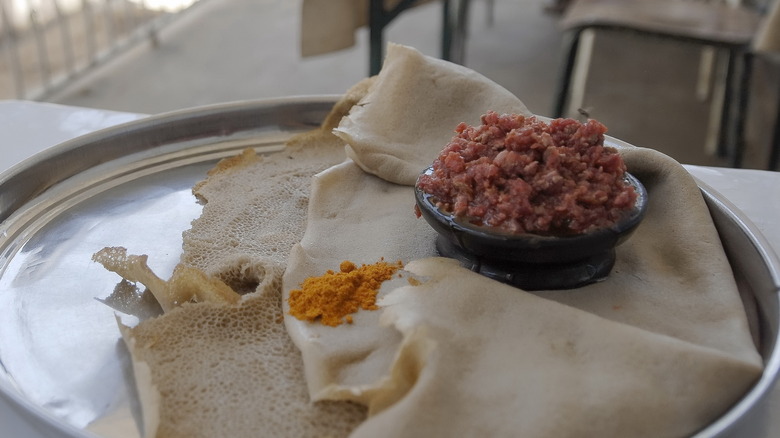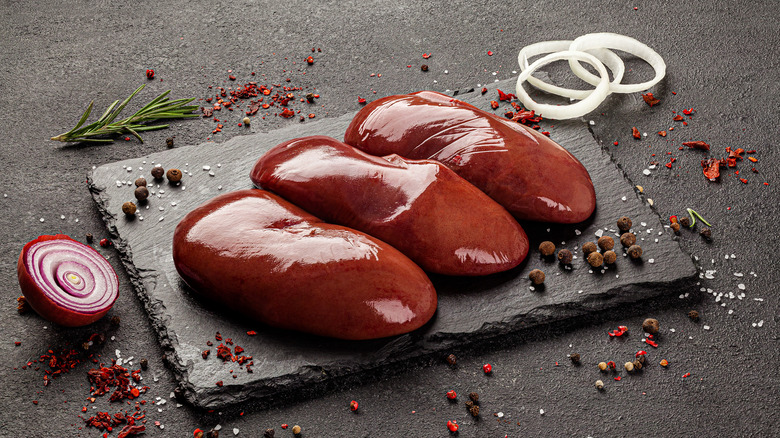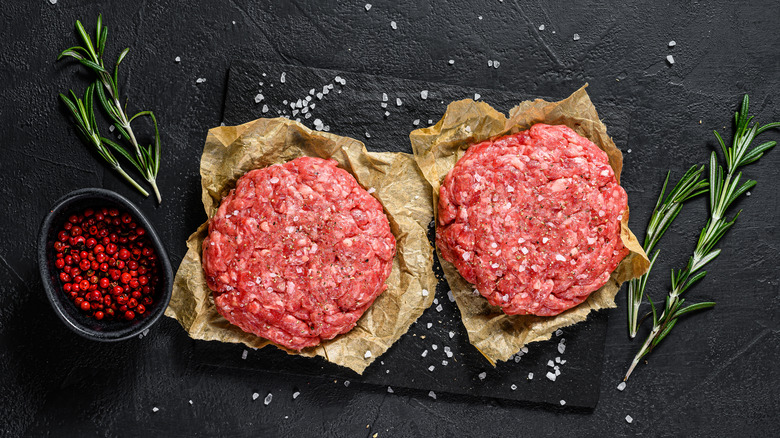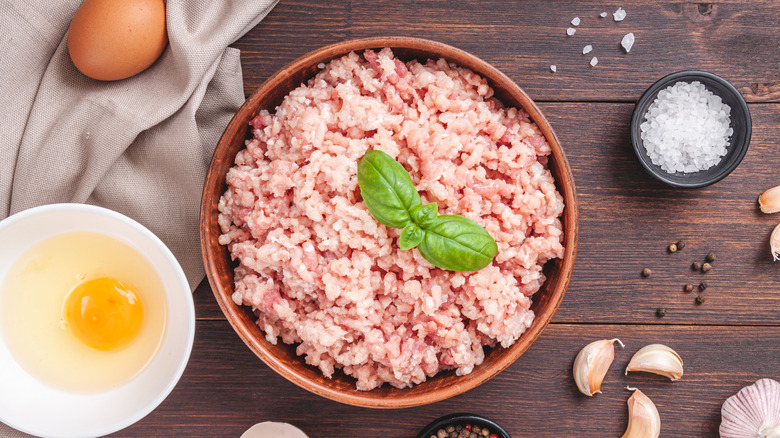The Meaty Ethiopian Finger Food You Should Know About
The history of Ethiopian cuisine is spicy! Since the dawn of the middle ages, Ethiopia has had access to spices not only from India but from Portugal and Asia (via Rumi). As a result, the country has been cultivating rich dishes for hundreds of years, with a focus on spice, protein, and native grains like teff. Many Ethiopian recipes utilize Berbere, which is a blend of spices like fenugreek, garlic, ginger, cloves, and more, giving the food pleasing earthy and warm tones.
And as for how Ethiopian food is supposed to be enjoyed, well, that's more of a hands-on approach! Food Network explains how the teff flour the country produces is used to make Injera bread — a gluten-free flatbread — that is used as a utensil to scoop up your food. In addition, much of Ethiopian cuisine is meant to be shared shoulder-to-shoulder with family and friends. Meals are a communal activity in Ethiopia, and the traditional dish, dulet, is no exception.
What is dulet?
If you're one of those people unafraid of sushi or steak tartare, you should absolutely try dulet. Ethiopian dishes are low in fat but high in protein; dulet is a perfect example of this. Dulet is a traditional meat dish made of tripe (stomach lining), liver, and beef minced together with peppers or onions and usually surrounded by veggies (via CNN). Raw meats tend to exhibit earthy flavors, especially when it comes to liver and tripe, and the tripe itself is also known for its chewy texture (via Master Class). By combining these three potent and flavorful meats together with Berbere, dulet takes on rich, spicy notes, which are balanced out with the soft and chewy consistency of the minced proteins (via Washington CityPaper).
Dulet can be eaten raw or cooked depending on your preference, but it is exclusively eaten using Injera, the sour bread pairing perfectly with the Berbere spiced meat. According to Serious Eats, dulet looks and feels like a plate of finely chopped meat that is savory in flavor and filling to eat. In addition, tripe has 18 grams of protein in every five ounces, liver is considered a superfood with all its vitamins and minerals, and beef has 26.1 grams of protein for every 3.5 ounces, making dulet nutrient and protein-rich (via Healthline). So if you decide to indulge in this Ethiopian delicacy, be prepared to tuck into a hearty meal.
Dulet vs. Kifto
Dulet is often compared to a similar and more popular Ethiopian dish called kifto. Like dulet, kifto is made of minced meat except, instead of using multiple sources, this dish solely uses raw beef, which is then marinated in chili powder, and niter kibbeh, which is a herbal butter (via Medium). It originated in the Gurague region of the country and received its name "kifto" because the Ethiopian root word "K-T-F" means to "mince," which is exactly how the beef in this dish is prepared (via DishRoots).
Kifto is eaten with Injera as well but is also often eaten alongside a soft cheese called ayib. Both dulet and kifto are made of chopped proteins, but the flavors and texture of the dishes vary from each other. Kifto is made only using one kind of meat, so its texture is consistent, but dulet is more dense and creamy with a mix of textures (via Serious Eats). It would be a mistake to consider these two recipes the same thing!
How to safely eat dulet
As with anything in life, eating raw meat comes with its risks. The National Library of Medicine says that when eating raw meat, you risk ingesting pathogens such as salmonella, Clostridium perfringens, E. coli, Listeria monocytogenes, and Campylobacter, all of which can lead to short and long-term illnesses, some of which can turn deadly if left untreated.
Dulet is made using tripe, liver, and beef, which are traditionally eaten raw like seafood is with sushi. So, if you are preparing your dulet at home yourself, it is important that you know where your meat is sourced from, how fresh it is, and how to store and prepare it safely. According to New South Wales Food Authority, you must ensure your meat is as fresh as possible and that you purchase it from an established and reputable butcher who knows that the meat will be consumed raw — the meat must be kept from being cross-contaminated and kept cold and refrigerated until the time of meal preparation and consumption. The longer the meat is exposed to the open, the less safe it becomes. The NSW Food Authority generally advises that anyone with a compromised immune system, young children, and senior citizens avoid eating raw meat and exercise extreme caution while doing so.



